Sonos PlayBase review
The PlayBar you can plonk your telly on
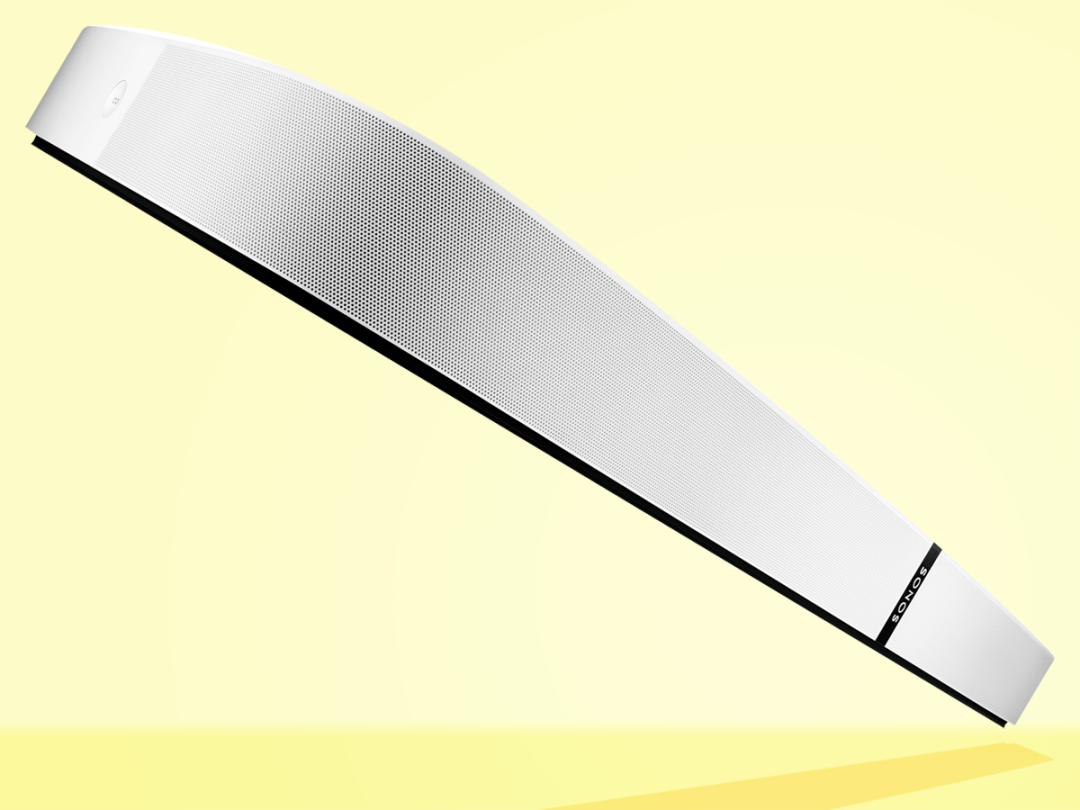
Sonos has always been about bringing simplicity to your wireless music set-up, and over the years it’s done it superbly. Enter, stage left, the new Sonos PlayBase – on a mission to do the same for your TV.
Sure, Sonos has had a go at TV audio before with the PlayBar, but the PlayBase goes a step further towards making your life easy.
It’s basically a PlayBar that your TV stands on, rather than one that goes in front of it or is wall-mounted beneath it – and that makes a bigger difference than you might imagine.
Sonos PlayBase design: simple, solid and riddled with holes (in a good way)
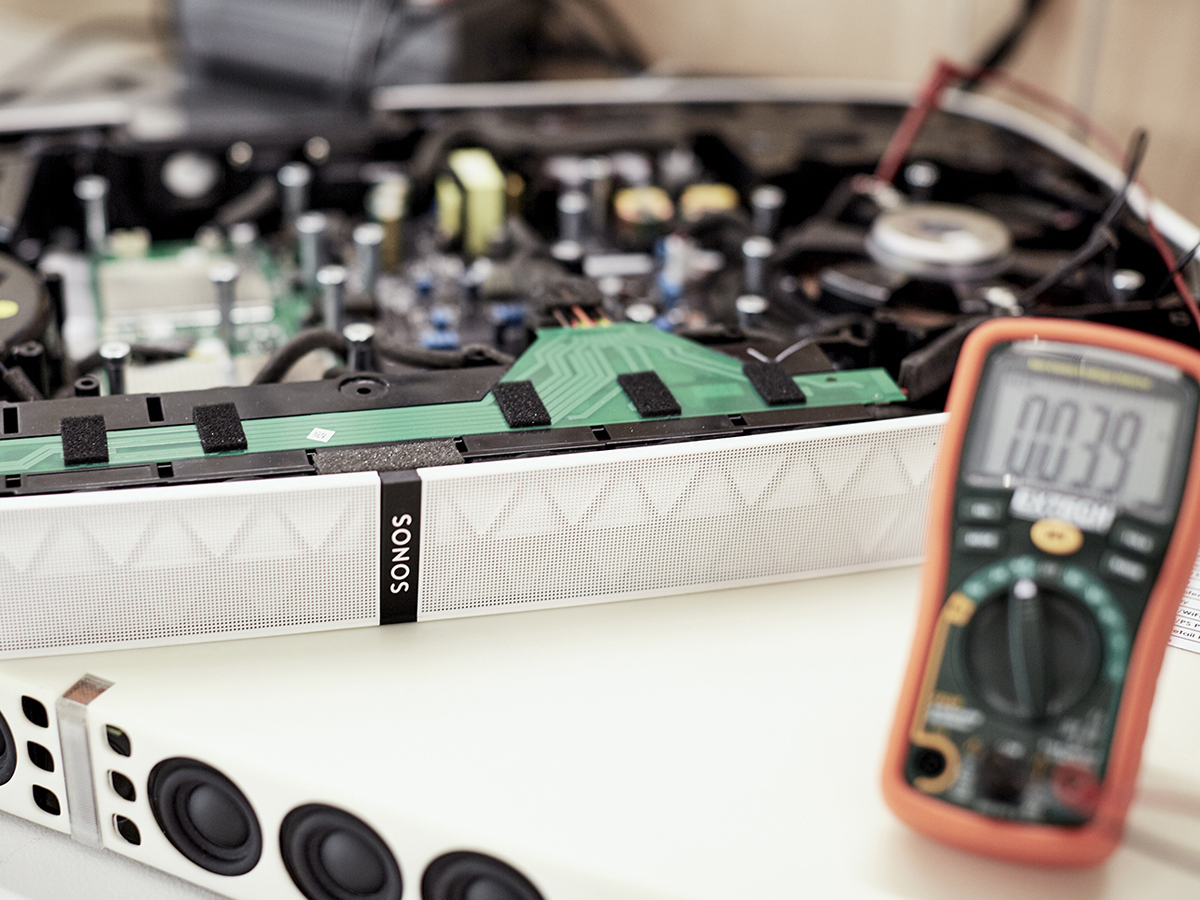
The problem with soundbars is that, unless you’re wall-mounting one under a wall-mounted TV, they can be rather awkward to find a home for.
Often too wide to fit on a normal shelf, they tend to find a home in front of the telly, where they look daft and can even block the signals from your remote control.
The PlayBar has an IR repeater to avoid the latter problem, but the company knows the former is a big issue, particularly as in the real world only a proportionally small number of people actually wall-mount their telly.
The solution? A soundbar that isn’t a soundbar at all, but a base upon which your TV can be plonked. It’s all very obvious when you think about it. So obvious, in fact, that lots of other manufacturers have already launched ‘soundbases’ over the last few years.
Sonos’ PlayBase, then, is a bit late to the party – but it’s also arriving in serious style.
Actually, perhaps “style” is the wrong word to use. It is, after all, fairly tricky to make a slab look sexy. Sonos has certainly had a good stab at it, though, rounding-off the PlayBase’s edges to give it a slightly pebble-like appearance, and carrying through the minimalist design touches that have helped make its speakers so overwhelmingly popular over the years.
There’s just one traditional button on the whole thing – a round, recessed little number with a chain-link symbol that’s, you guessed it, used for linking the PlayBase to your network and other Sonos speakers, should you have them.
On the front of the top panel is a little, textured play/pause button, which is flanked by two tiny icons that highlight touch surfaces that can be used to adjust volume. Truth be told, it’ll be rare that you’ll find yourself prodding the PlayBase itself because, once the initial link has been made, your interactions with it will be almost entirely via the Sonos (or Spotify) app.
It’s all very simple, but that’s not to say the PlayBase isn’t a precision-engineered piece of kit. The chassis is seam-free and super-solid – capable of supporting TVs that weigh up to 35kg. TVs heavier than this are practically unheard of these days. Most TVs will simply stand on top of the PlayBase, while some (such as the Samsung UE43KS7500 we tested it with) have widely spaced feet that straddle the base very neatly.
In short, it’s fairly unlikely that you’ll have any issue physically combining your TV and a PlayBase but if you do, or you want to make the setup even neater, a company called Sanus sells a stand/bracket that will replace you TV’s pedestal and make it look as though it’s floating above the PlayBase.
One piece of advice about positioning: don’t be tempted to put the PlayBase on the shelf under your TV in an enclosed rack, as that will hinder the Sonos’ prodigious ability to spread sound through your room (more on which below).
Sonos PlayBase setup: more simplicity, for better and for worse
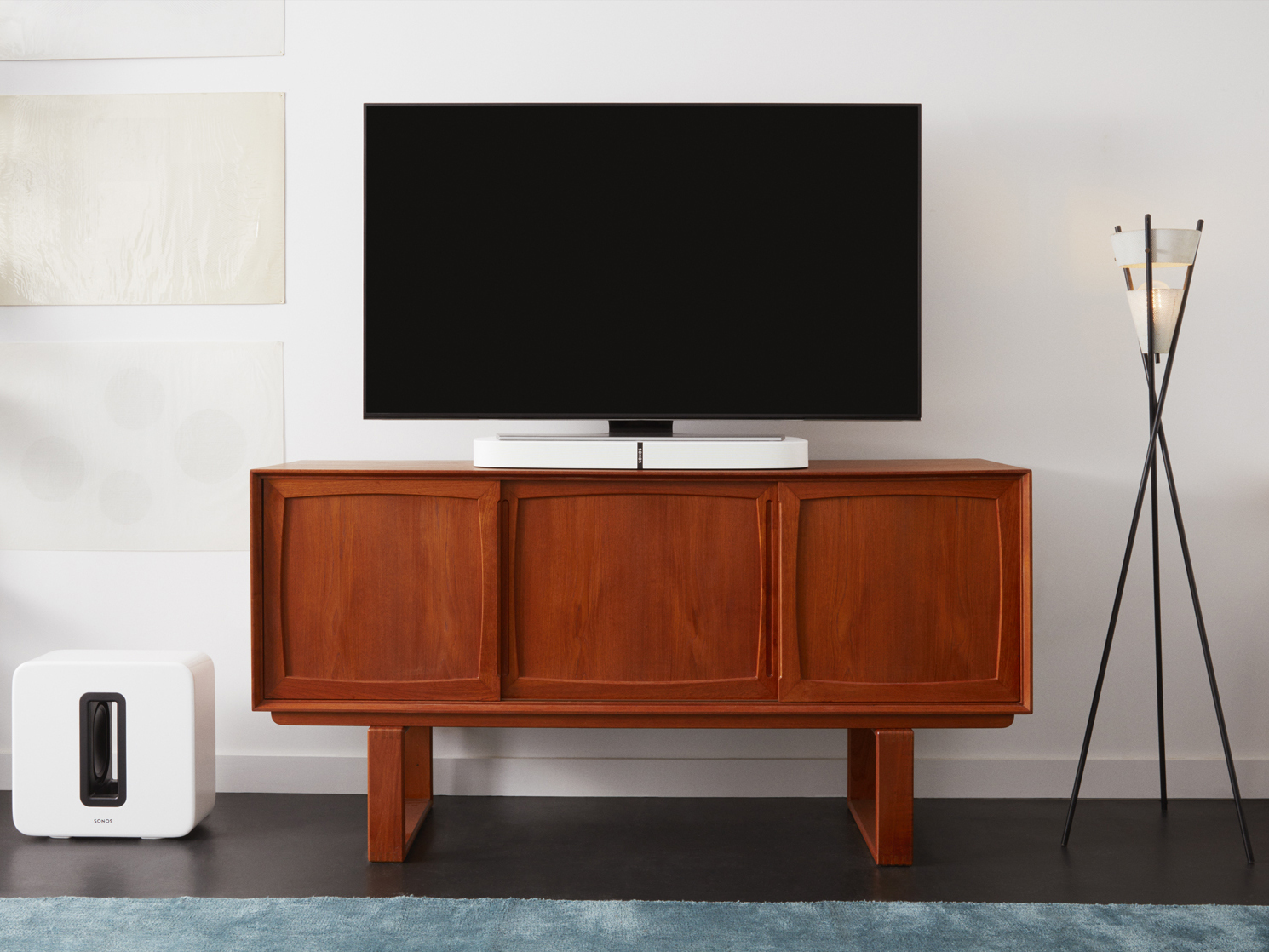
As with the PlayBar, the PlayBase has just one audio input – optical. The idea is that all of your video sources (console, set-top box, streamer etc) run into your TV, and just the one optical cable takes the sound from your TV and into the PlayBase.
The fact that it doesn’t have a battery of different inputs, particularly HDMI, might sound a bit last-gen, but Sonos is determined to tread the path of simplicity.
That’s a noble goal but it can create some issues, especially when it’s not shared by the other kit that you’ve got. If you want the PlayBase to perform as intended you need to ensure that all of your sources are sending a Dolby Digital 5.1 signal to your TV, and that your TV is then passing that signal unmolested via the optical cable to you PlayBase. It’s very likely that all of your kit will do that, but it can involve delving into a lot of menus to make it happen, so what should be very simple can become quite complex. Certainly, having tested the PlayBase with a variety of tellies and a whole load of different sources, I can confirm that it can be quite a drawn-out, head-scratching experience to get everything working as it should.
In fairness to Sonos, it’s not its fault that other companies have convoluted menu systems, and its tech support is very helpful indeed should you need it (I did). One way or another you will get it working as it should, but it might take some perseverance to get there.
I can’t help but think that a solution such as the Yamaha YSP-2700 soundbar, which accepts just about any signal via HDMI and then passes just the video up to your TV, is actually ultimately more simple for the person using it.
Once you’ve made the physical connection between your TV and the PlayBase, you open the Sonos app on your iPhone or Android handset and are taken through the other elements of the setup in a very easy to follow step-by-step set of instructions, complete with animations, videos and diagrams.
You’ll assign the PlayBase to a specific room of your house, ensure the connections have been made correctly and, if you’re an iPhone user, even tune the sound using Trueplay. This involves the speaker blasting out some test sounds that you use your iPhone’s speaker to measure both in the position that you watch telly from, and from just about every corner of your room. It all takes about three minutes and it can have a huge impact on sound quality (more on which below). So much so, that if you’re an Android user I heartily recommend persuading an iPhone-toting friend to come over and give you a hand.
Once the Trueplay tuning is done, you’re good to get listening.
Sonos PlayBase sound: fills the room with movie sound

And when you do get listening you’re going to be blown away by the sheer size of the sound that the PlayBase produces.
Under the skin this is a 3.1 system, but one that uses an array of ten drivers to produce a sound that’s far wider than you’d imagine possible from the very slim and compact unit. It seems that Sonos doesn’t particularly like talking about ‘virtual surround sound’, but the PlayBase does indeed bounce sound off the walls – and the degree to which it fills the room with audio is really impressive.
Rather than being constrained to a narrow channel only as wide as your TV, sounds move from the far-left of your room seamlessly across the screen and then to the far-right. If you’re going from your TV’s own speakers to the PlayBase, you’re going to be genuinely amazed by the transformation.
Do be aware, though, that as with any sound setup that relies on bouncing sound off walls, the size and shape of your room, as well as its furnishings, will have an impact on the sound. Having listened to the PlayBase in a number of different rooms I can say that it copes with most very well indeed, but one room had floor-to-ceiling fabric blinds on one wall that seemed to soak up too much of the sound, leading to a wonky presentation that stretched exactly as it should to the left but was extremely narrow to the right. With the blinds open, the problem disappeared as the PlayBase was able to do its bouncing thing with the windows.
Clearly, this is not the sort of issue that most people are going to face, but it is worth being aware that if you have an unusual room is could cause an issue. The good news is that if you buy your PlayBase directly from Sonos you get 100 days to return it free-of-charge if it doesn’t work for you. You can’t really say fairer than that.
Assuming you’re in a relatively typical room, you will get that awesome breadth of sound, which combines with solid, weighty bass to produce an impressively epic presentation.
That bass isn’t overblown or artificial – Sonos is at great pains to insist that its aim is natural sound, and that really is what you get here. Unlike the PlayBar, which physically struggles to produce genuine bass so rather overcompensates through software, the PlayBase has a quite ingenious woofer that produces far more authentic bass frequencies that have greater range, punch and that integrate better with the rest of the presentation.
But there are issues at the other end of the frequency range, with the treble proving to be quite a bit too zingy, sharp and sibilant. What this means is that big effects can be dominated by a harsh high-end, and the ‘ess’ sound of voices is overdone – irritatingly so once you’ve noticed it.
This flaw is exacerbated by the Trueplay setting, which boosts treble and bass specifically, but it’s also there when you turn Trueplay off, and the far narrower and more muffled sound the PlayBase produces without Trueplay is best avoided. Yes, the mid-range, which is where all the voices are, is slightly pushed back in Trueplay, but not to the extent that dialogue is ever anything less than very clear.
It’s a shame then, that the treble is so zingy, because it detracts from what is an otherwise genuinely excellent sound system for TV and movies, and that’s before you consider the optional upgrade to true 5.1 surround. This you can do by adding two Play:1, Play:3 or Play:5 speakers to act as surround-left and surround-right satellites, and a Sonos Sub for bass duties.
Would I go down that route? I’d certainly be tempted. Because the speakers interact wirelessly you don’t need to run cables right across your lounge (although each speaker does need to be connected to a power socket), and that makes a Sonos surround system very neat compared to almost any alternatives.
True, this is an expensive way to get surround sound (£1800 all-in), and for the same money you could build a system that will sound better and handle higher-end sound formats, but for style, simplicity and minimalism it’s hard to beat.
Sonos PlayBase music: still a Sonos speaker at heart
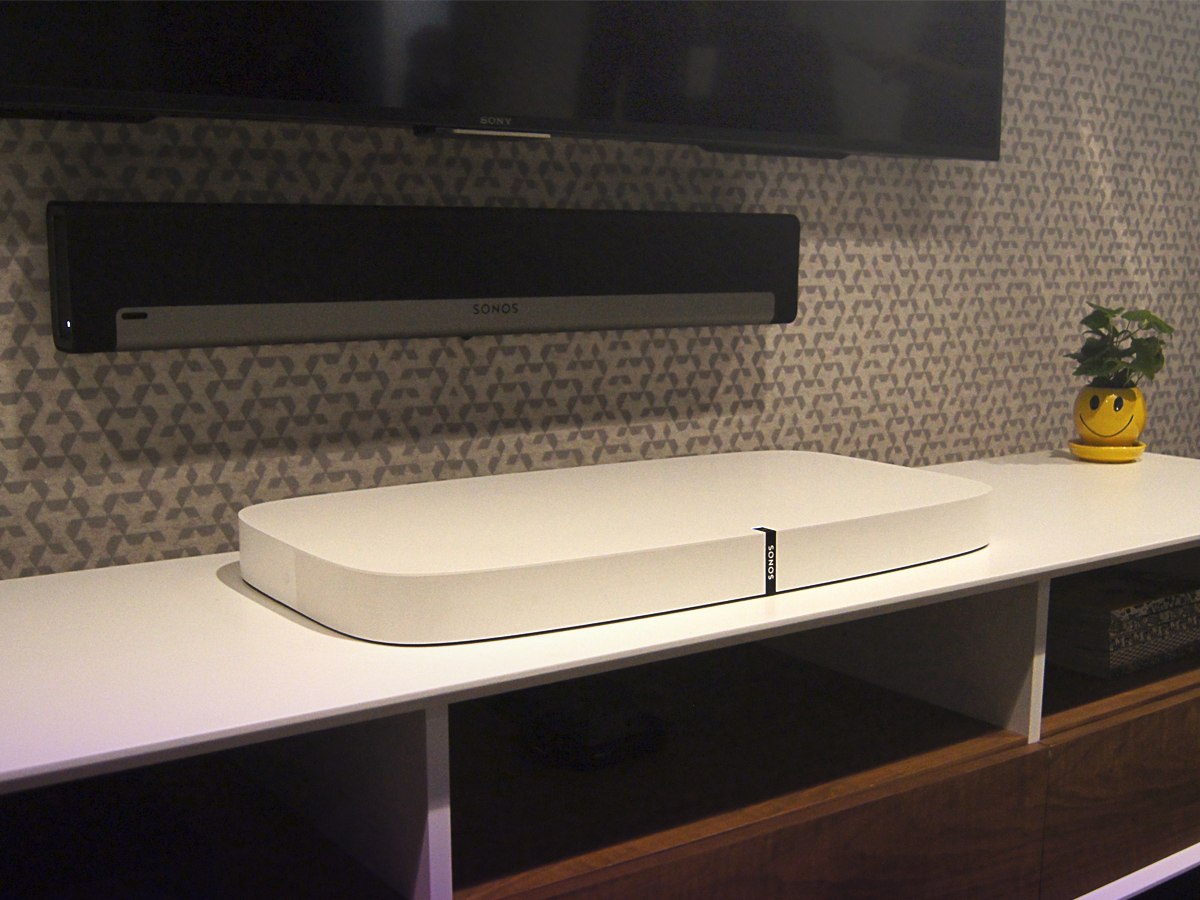
With the PlayBase, TV sound is just half the story, because it’s also just as much of a music machine as any other Sonos speaker. And that means your musical options are almost limitless.
Sonos still supports just about every music streaming service under the sun, from Spotify to Tidal, Apple Music to Amazon. Any music stored on your computer, NAS or phone is also fair game, and you can stream internet radio via TuneIn, too.
Practically the only stuff you can’t play is hi-res audio. You know, the better-than-CD stuff we keep hearing about. Sonos seems to be extremely unimpressed with that sort of thing and, given the variable quality of some of the so-called Studio Masters made available so far, that’s quite understandable. But now that MQA is starting to break through and is available via Tidal, it would be good to see Sonos supporting it.
I honestly can’t see that being majorly off-putting to most potential PlayBase buyers, though. In fact, the only thing you really need to worry about when considering the PlayBase as a music speaker is that sharp treble and the sibilance. As a test, play Jayou by Jurassic 5 – you’ll find that the snare drum sounds rather harsh and the regular esses in the lyrics stand out far too much.
Over time, this is annoying enough to badly detract from the PlayBase’s other great strengths.
Sonos PlayBase verdict
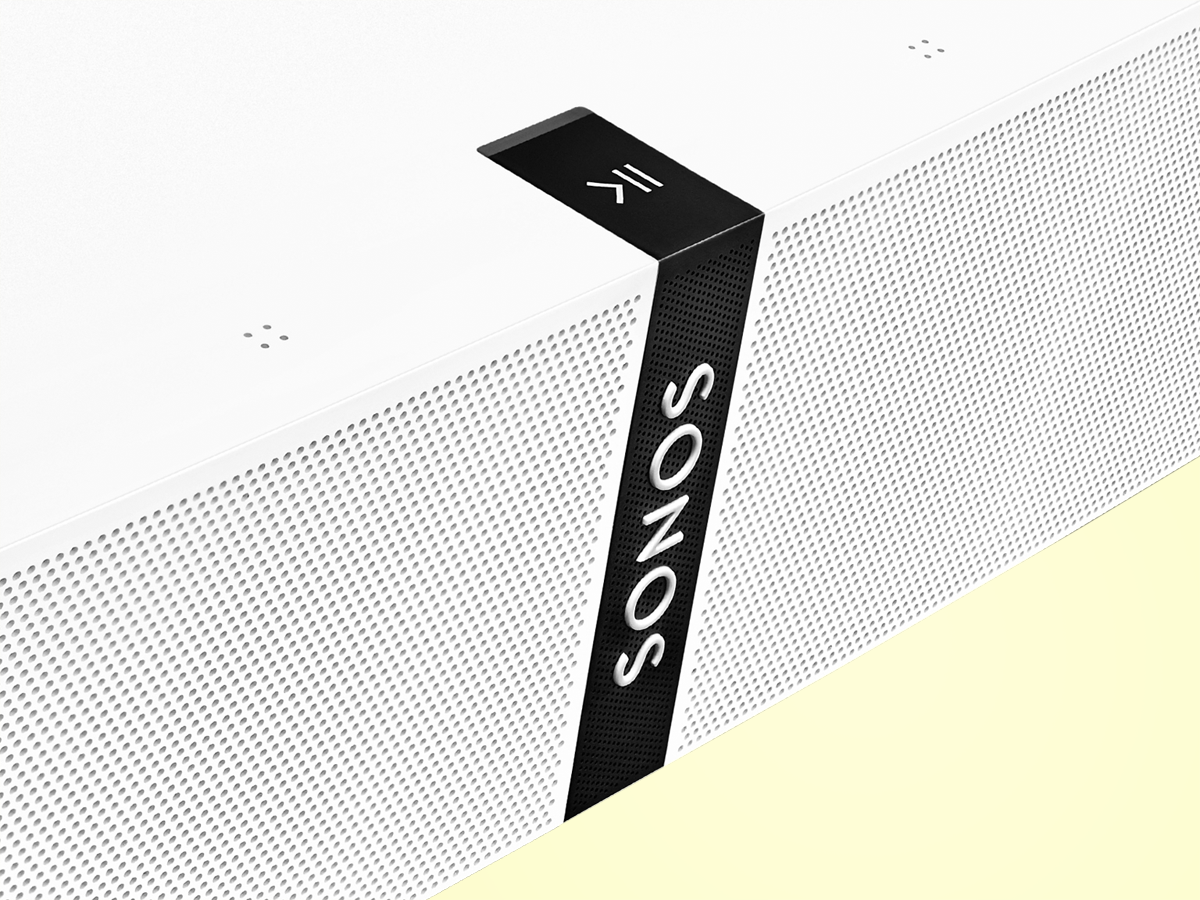
The PlayBase is very close to being a brilliant TV speaker solution, but it falls just short.
It’s undeniably a huge upgrade over the sound produced by any TV, offering width, scale, dynamism and excitement that will blow your mind if that’s what you’re used to. Even compared to the vast majority of other soundbars and bases the Sonos is in most ways streets ahead, and that’s before you consider all of the regular Sonos features this has and which rivals do not.
But there’s a fly in the ointment, and that fly is treble that’s sharp and harsh enough to distract and detract from the other things that the PlayBase does so well.
In a battle between the PlayBase and the PlayBar, it’s the PlayBar that I’d take. Yes, it has its own flaws – it isn’t as full-bodied, punchy or dynamic as the PlayBase – but its treble is far better controlled and that goes a good way to making up for its other flaws.
But, as mentioned, the PlayBar doesn’t work very well unless you’re wall-mounting. If you’re not and you’re a Sonos fan looking for a speaker you can plonk your telly on, there’s still loads to like with the PlayBase – and remember, that generous returns policy means you can always try one out for yourself.
Stuff Says…
One significant sonic flaw prevents the otherwise excellent SoundBase getting the full five stars
Good Stuff
Amazingly big, wide sound for a box this compact
Natural, punchy bass
Does all of the great things any other Sonos speaker can
Can be upgraded to a full 5.1 system
Bad Stuff
Treble is harsh, often annoyingly so
Optical-only isn’t very flexible – or even necessarily that simple
Won’t work perfectly in every room



